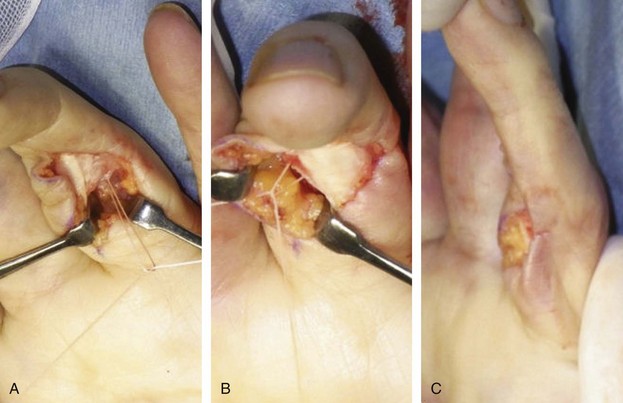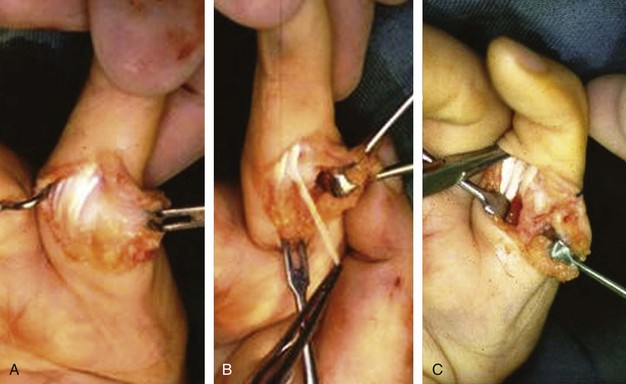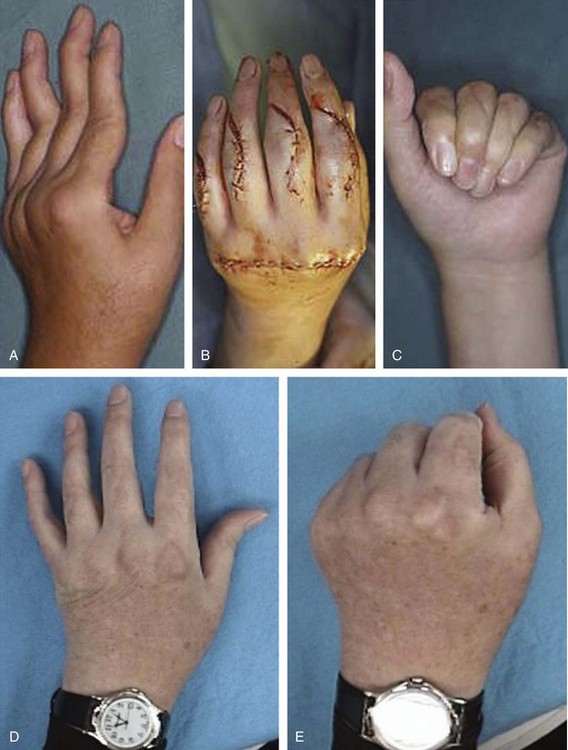Procedure 33 Correction of Swan-Neck Deformity in the Rheumatoid Hand
![]() See Video 25: Lateral Band Release for Rheumatoid Swan-Neck Deformity
See Video 25: Lateral Band Release for Rheumatoid Swan-Neck Deformity
Indications
 Treatment of swan-neck deformity is based on the flexibility of the proximal interphalangeal (PIP) joint and condition of the joint cartilage.
Treatment of swan-neck deformity is based on the flexibility of the proximal interphalangeal (PIP) joint and condition of the joint cartilage.
 The Nalebuff classification is the most widely accepted and useful method for surgical decision-making.
The Nalebuff classification is the most widely accepted and useful method for surgical decision-making.
 Type I deformities need a procedure to limit PIP hyperextension (e.g., splint, dermodesis, flexor digitorum superficialis [FDS] tenodesis) and restore distal interphalangeal (DIP) extension (e.g., tenodermodesis, fusion).
Type I deformities need a procedure to limit PIP hyperextension (e.g., splint, dermodesis, flexor digitorum superficialis [FDS] tenodesis) and restore distal interphalangeal (DIP) extension (e.g., tenodermodesis, fusion).
 Type II deformities require an intrinsic release and/or MCP joint arthroplasty in addition to the procedure for type I.
Type II deformities require an intrinsic release and/or MCP joint arthroplasty in addition to the procedure for type I.
 Type III deformities require restoration of flexion of the PIP joint by manipulation, lateral band mobilization, and lengthening of the central slip depending on the severity of soft tissue contracture.
Type III deformities require restoration of flexion of the PIP joint by manipulation, lateral band mobilization, and lengthening of the central slip depending on the severity of soft tissue contracture.
 Arthrodesis of the PIP joint is often recommended for type IV deformities with joint destruction; however, implant arthroplasty is always an option.
Arthrodesis of the PIP joint is often recommended for type IV deformities with joint destruction; however, implant arthroplasty is always an option.
Examination/Imaging
Clinical Examination
 Active and passive range of motion of the PIP joint is tested with the MCP joint in extension and flexion. This is to evaluate whether the intrinsic muscles are contributing to the restricted PIP joint motion. Restriction in radial and ulnar deviation is also tested with the MCP joint in extension to evaluate which of the intrinsic muscles is responsible for the PIP joint tightness.
Active and passive range of motion of the PIP joint is tested with the MCP joint in extension and flexion. This is to evaluate whether the intrinsic muscles are contributing to the restricted PIP joint motion. Restriction in radial and ulnar deviation is also tested with the MCP joint in extension to evaluate which of the intrinsic muscles is responsible for the PIP joint tightness.
 When active motion of the PIP is not nearly equal to passive motion, adhesions of the flexor tendons must be suspected.
When active motion of the PIP is not nearly equal to passive motion, adhesions of the flexor tendons must be suspected.
 When the PIP joint is flexible regardless of the metacarpophalangeal (MCP) joint position (type I), a PIP extension block splint may correct the deformity while restoring full flexion (Fig. 33-1A).
When the PIP joint is flexible regardless of the metacarpophalangeal (MCP) joint position (type I), a PIP extension block splint may correct the deformity while restoring full flexion (Fig. 33-1A).
 When flexion of the PIP joint is restricted with the MCP joint in extension and radial deviation, ulnar intrinsic muscle tightness exists.
When flexion of the PIP joint is restricted with the MCP joint in extension and radial deviation, ulnar intrinsic muscle tightness exists.
 When passive flexion of the PIP is limited with the MCP joint in flexion, the pathology is the stiff PIP joint (type III) (Fig. 33-1B).
When passive flexion of the PIP is limited with the MCP joint in flexion, the pathology is the stiff PIP joint (type III) (Fig. 33-1B).
 The typical swan-neck deformity is associated with flexion contracture of the MCP joint, hyperextension of the PIP joints, and dorsally displaced lateral bands (Fig. 33-2).
The typical swan-neck deformity is associated with flexion contracture of the MCP joint, hyperextension of the PIP joints, and dorsally displaced lateral bands (Fig. 33-2).
Surgical Anatomy
 A swan-neck deformity can occur as a result of abnormalities at the wrist, MCP joint, PIP joint, or DIP joint (Fig. 33-3).
A swan-neck deformity can occur as a result of abnormalities at the wrist, MCP joint, PIP joint, or DIP joint (Fig. 33-3).
 Synovitis within the PIP joint leads to stretching, weakening, and eventually destruction of the volar plate and collateral ligaments and the insertion of the FDS, resulting in the loss of palmar restraint at the PIP joint. This loss allows the normal extensor forces to cause abnormal hyperextension of the PIP joint.
Synovitis within the PIP joint leads to stretching, weakening, and eventually destruction of the volar plate and collateral ligaments and the insertion of the FDS, resulting in the loss of palmar restraint at the PIP joint. This loss allows the normal extensor forces to cause abnormal hyperextension of the PIP joint.
 Synovitis of the MCP joint causes attenuation of the volar plate, resulting in volar subluxation of the MCP joint. Over time, volar subluxation results in shortening of the intrinsic muscles, leading to PIP joint hyperextension and ultimately swan-neck deformity.
Synovitis of the MCP joint causes attenuation of the volar plate, resulting in volar subluxation of the MCP joint. Over time, volar subluxation results in shortening of the intrinsic muscles, leading to PIP joint hyperextension and ultimately swan-neck deformity.
 DIP joint synovitis can cause weakening and rupture of the terminal extensor tendon insertion, leading to the development of a mallet deformity. The proximal migration of the terminal extensor insertion causes the lateral bands to become lax. All the power of the common extrinsic extensor is now directed toward the central slip that inserts into the middle phalanx. Over time, the volar supporting structures of the PIP joint are weakened, and the PIP joint is forced into hyperextension, resulting in a swan-neck deformity.
DIP joint synovitis can cause weakening and rupture of the terminal extensor tendon insertion, leading to the development of a mallet deformity. The proximal migration of the terminal extensor insertion causes the lateral bands to become lax. All the power of the common extrinsic extensor is now directed toward the central slip that inserts into the middle phalanx. Over time, the volar supporting structures of the PIP joint are weakened, and the PIP joint is forced into hyperextension, resulting in a swan-neck deformity.
 Synovitis at the wrist joint can lead to carpal collapse, carpal supination, and ulnar translation. Carpal collapse leads to a relative lengthening (relaxation) of the long flexor and extensor tendons. The interosseous muscle can then overpower the action of the extrinsic muscles and lead to MCP joint flexion and PIP joint extension, which over a prolonged period causes a physiologic shortening of the intrinsic muscles.
Synovitis at the wrist joint can lead to carpal collapse, carpal supination, and ulnar translation. Carpal collapse leads to a relative lengthening (relaxation) of the long flexor and extensor tendons. The interosseous muscle can then overpower the action of the extrinsic muscles and lead to MCP joint flexion and PIP joint extension, which over a prolonged period causes a physiologic shortening of the intrinsic muscles.
Procedures to Prevent Hyperextension of the PIP Joint (for Types 1 to 3)
Bone Anchor Repair of the Volar Plate
Step 2
 The accessory collateral ligament is identified and incised (Fig. 33-5A and B). The volar plate with the entire flexor sheath is retracted laterally to expose the head of the proximal phalanx (Fig. 33-5C).
The accessory collateral ligament is identified and incised (Fig. 33-5A and B). The volar plate with the entire flexor sheath is retracted laterally to expose the head of the proximal phalanx (Fig. 33-5C).
Step 3
Step 4
 The bone anchor typically has two needles with sutures. One needle is passed from the dorsolateral aspect of the volar plate (Fig. 33-7A) to emerge at the central portion of the volar plate (Fig. 33-7B). It is then passed through the edge of the previously divided accessory collateral ligament (Fig. 33-7C).
The bone anchor typically has two needles with sutures. One needle is passed from the dorsolateral aspect of the volar plate (Fig. 33-7A) to emerge at the central portion of the volar plate (Fig. 33-7B). It is then passed through the edge of the previously divided accessory collateral ligament (Fig. 33-7C).
Step 5
 The sutures are tied to each other, aiming to maintain the PIP joint in about 10 degrees of flexion (Fig. 33-8A).
The sutures are tied to each other, aiming to maintain the PIP joint in about 10 degrees of flexion (Fig. 33-8A).
 The other needle is passed in a similar fashion on the other side. After the second suture is tied, the PIP joint should be positioned in about 15 to 20 degrees of flexion. The first suture loop needs to shift medially to develop sufficient tension in the second suture loop (Fig. 33-8B and C).
The other needle is passed in a similar fashion on the other side. After the second suture is tied, the PIP joint should be positioned in about 15 to 20 degrees of flexion. The first suture loop needs to shift medially to develop sufficient tension in the second suture loop (Fig. 33-8B and C).
FDS Tenodesis
Retinacular Ligament Reconstruction
Step 2
 The divided lateral band is dissected distally and passed below the Cleland ligament so that the ulnar lateral band is now volar to the axis to the PIP joint to maintain the PIP joint in flexion. The lateral band is sutured to the A2 pulley or into the bone of the proximal phalanx to maintain the PIP joint in 15 to 20 degrees of flexion (Fig. 33-10B and C).
The divided lateral band is dissected distally and passed below the Cleland ligament so that the ulnar lateral band is now volar to the axis to the PIP joint to maintain the PIP joint in flexion. The lateral band is sutured to the A2 pulley or into the bone of the proximal phalanx to maintain the PIP joint in 15 to 20 degrees of flexion (Fig. 33-10B and C).
Procedures to Correct DIP Joint Deformity (for Types 1 to 4)
Procedures to Correct a Stiff Swan-Neck Deformity (Type 3)
Lateral Band Mobilization
Step 1
Step 2
Step-Cut (Z) Lengthening of the Central Slip
Step 1
 A step-cut lengthening of the central slip should be considered if shortening of the central slip restricts PIP joint flexion after manipulation of the PIP joint and mobilization of the lateral bands has been attempted.
A step-cut lengthening of the central slip should be considered if shortening of the central slip restricts PIP joint flexion after manipulation of the PIP joint and mobilization of the lateral bands has been attempted.
 A Z-incision of the central slip is made beginning 3 to 4 mm proximal to the insertion at the middle phalanx (marked as black dot on figures) and extended 1 to 1.5 cm proximally (depending on the severity of the deformity) (Fig. 33-13A).
A Z-incision of the central slip is made beginning 3 to 4 mm proximal to the insertion at the middle phalanx (marked as black dot on figures) and extended 1 to 1.5 cm proximally (depending on the severity of the deformity) (Fig. 33-13A).
Postoperative Care and Expected Outcomes
 Active motion should be encouraged as early as the second postoperative day.
Active motion should be encouraged as early as the second postoperative day.
 A dorsal extension block splint is used for 2 weeks until the surgical wounds have healed. This is followed by a thermoplastic figure-of-eight splint for an additional 8 weeks.
A dorsal extension block splint is used for 2 weeks until the surgical wounds have healed. This is followed by a thermoplastic figure-of-eight splint for an additional 8 weeks.
 After manipulation of the PIP joint or mobilization of lateral bands for a type III deformity, the PIP joint should be kept in flexion with a splint for 1 or 2 weeks to stretch the dorsal soft tissue. Patients should continue active flexion except in cases that also required central slip lengthening. These patients should be immobilized for 3 to 4 weeks.
After manipulation of the PIP joint or mobilization of lateral bands for a type III deformity, the PIP joint should be kept in flexion with a splint for 1 or 2 weeks to stretch the dorsal soft tissue. Patients should continue active flexion except in cases that also required central slip lengthening. These patients should be immobilized for 3 to 4 weeks.
 The results of surgery are unpredictable for advanced swan-neck deformity, and the percentage of good results is small. However, even if motion is lost, the flexed position of the PIP joint is functionally much better than the hyperextended position. Therefore, one must not hesitate to perform surgery for advanced swan-neck deformity as long as PIP joint hyperextension can be prevented.
The results of surgery are unpredictable for advanced swan-neck deformity, and the percentage of good results is small. However, even if motion is lost, the flexed position of the PIP joint is functionally much better than the hyperextended position. Therefore, one must not hesitate to perform surgery for advanced swan-neck deformity as long as PIP joint hyperextension can be prevented.
 Figure 33-14 shows the appearance of the patient in Figure 33-2 one year after surgery. The patient underwent release of the ulnar intrinsic muscle, manipulation of the PIP joints, tenodermodesis of the DIP joint of the index and small fingers, and lateral band mobilization and volar plate reconstruction using bone anchors for the long and ring fingers. The swan-neck deformity was corrected, and all fingers had reasonable flexion except the small finger where the deformity recurred.
Figure 33-14 shows the appearance of the patient in Figure 33-2 one year after surgery. The patient underwent release of the ulnar intrinsic muscle, manipulation of the PIP joints, tenodermodesis of the DIP joint of the index and small fingers, and lateral band mobilization and volar plate reconstruction using bone anchors for the long and ring fingers. The swan-neck deformity was corrected, and all fingers had reasonable flexion except the small finger where the deformity recurred.
 Figure 33-15 shows a stiff swan-neck deformity with MP flexion-contractures of all fingers in a 49-year-old woman. She underwent intrinsic muscle release and lateral band mobilization of all fingers. In addition, lengthening of the central slip was done for the long and ring fingers. An extension block pin was inserted into the head of the proximal phalanx to protect the central slip repair, and the distal wounds were left open. Excellent flexion of the PIP joint in 6 months (Fig. 33-15C) and at the10-year follow-up showed that the correction of the deformity was maintained (Fig. 33-15D and 33-15E).
Figure 33-15 shows a stiff swan-neck deformity with MP flexion-contractures of all fingers in a 49-year-old woman. She underwent intrinsic muscle release and lateral band mobilization of all fingers. In addition, lengthening of the central slip was done for the long and ring fingers. An extension block pin was inserted into the head of the proximal phalanx to protect the central slip repair, and the distal wounds were left open. Excellent flexion of the PIP joint in 6 months (Fig. 33-15C) and at the10-year follow-up showed that the correction of the deformity was maintained (Fig. 33-15D and 33-15E).
de Bruin M, van Vliet DC, Smeulders MJ, Kreulen M. Long-term results of lateral band translocation for the correction of swan neck deformity in cerebral palsy. J Pediatr Orthop. 2010;30:67-70.
Kiefhaber TR, Stricland JW. Soft tissue reconstruction for rheumatoid swan-neck and boutonniere deformities: long term results. J Hand Surg [Am]. 1993;18:984-989.
Ozturk S, Zor F, Sengezar M, Isik S. Correction of bilateral congenital swan-neck deformity by use of Mitek mini anchor: a new technique. Br J Plast Surg. 2005;56:822-825.


































